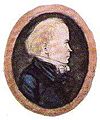Swedish Romantic literature

Swedish Romantic literature denotes
One significant reason was that several poets for the first time worked towards a common direction. Four of the main romantic poets that made significant contributions to the movements were: the professor of history Erik Gustaf Geijer, the loner Erik Johan Stagnelius, professor of Greek language Esaias Tegnér and professor of aesthetics and philosophy P.D.A. Atterbom.[4]
-
Atterbom, 1831
-
Geijer
-
Stagnelius, posthumous medallion
Early liberalism
Fredrika Bremer (1801–1865) was the first writer of realism novel, in the spirit of Jane Austen, and her most important contribution is that she introduced the novel in Swedish on a large scale. Her most important novel was her last: Hertha, in 1856. Hertha is not so much a novel as it is a political debate of women's rights.
Viktor Rydberg (1828–1895) was a key figure in the Swedish culture between 1855 and the modern breakthrough in 1879. In the spirit of Dickens, Rydberg wrote adventurous novels and stories that in reality were dealing with the poor and exposed people of society. Several works tried to define a world where Christianity became integrated with humanistic ideals of ancient Greece. Rydberg was also noted for groundbreaking historical and theological works.[10]
When Sweden lost
-
Almqvist, circa 1835
-
Rydberg, 1876
-
Fredrika Bremer, 1849
Notes and references
- Algulin, Ingemar, A History of Swedish Literature, published by the ISBN 91-520-0239-X
- Gustafson, Alrik A History of Swedish Literature (2 volumes), 1961.
- Tigerstedt, E.N., Svensk litteraturhistoria (Tryckindustri AB, Solna, 1971)






